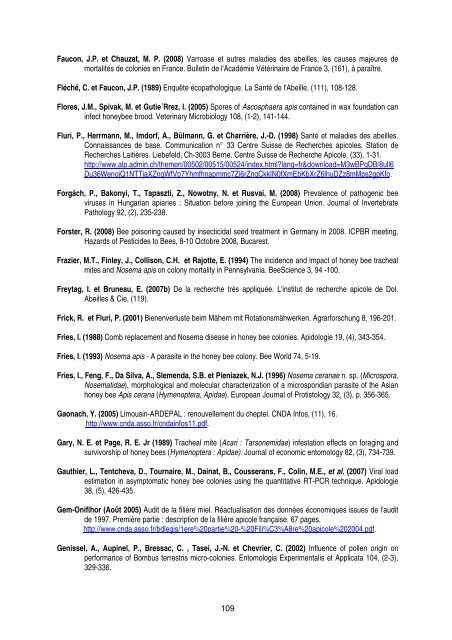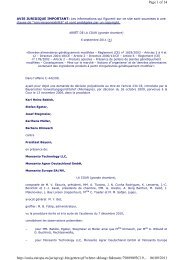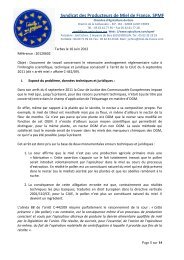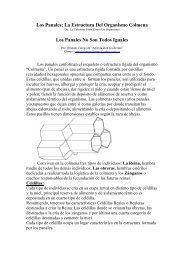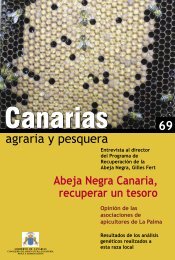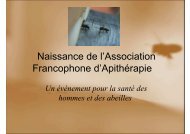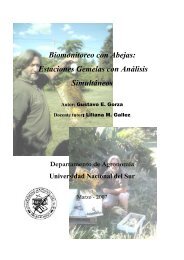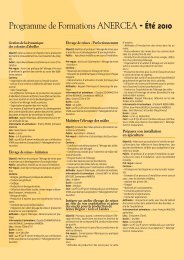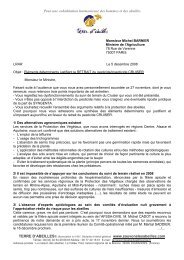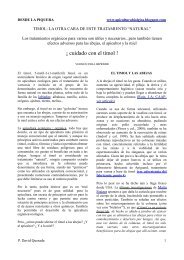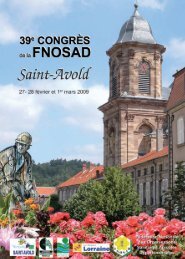Faucon, J.P. <strong>et</strong> Chauzat, M. P. (2008) Varroase <strong>et</strong> autres maladies <strong>des</strong> abeilles, les causes majeures demortalités de <strong>colonies</strong> en France. Bull<strong>et</strong>in de l'Académie Vétérinaire de France 3, (161), à paraître.Fléché, C. <strong>et</strong> Faucon, J.P. (1989) Enquête écopathologique. La Santé de l'Abeille, (111), 108-128.Flores, J.M., Spivak, M. <strong>et</strong> Gutie´Rrez, I. (2005) Spores of Ascosphaera apis contained in wax foundation caninfect honeybee brood. V<strong>et</strong>erinary Microbiology 108, (1-2), 141-144.Fluri, P., Herrmann, M., Imdorf, A., Bülmann, G. <strong>et</strong> Charrière, J.-D. (1998) Santé <strong>et</strong> maladies <strong>des</strong> abeilles.Connaissances de base. Communication n° 33 Centre Suisse de Recherches apicoles. Station deRecherches Laitières. Liebefeld, Ch-3003 Berne. Centre Suisse de Recherche Apicole, (33), 1-31.http://www.alp.admin.ch/themen/00502/00515/00524/index.html?lang=fr&download=M3wBPgDB/8ull6Du36WenojQ1NTTjaXZnqWfVp7Yhmfhnapmmc7Zi6rZnqCkkIN0fXmEbKbXrZ6lhuDZz8mMps2gpKfo.Forgách, P., Bakonyi, T., Tapaszti, Z., Nowotny, N. <strong>et</strong> Rusvai, M. (2008) Prevalence of pathogenic beeviruses in Hungarian apiaries : Situation before joining the European Union. Journal of InvertebratePathology 92, (2), 235-238.Forster, R. (2008) Bee poisoning caused by insecticidal seed treatment in Germany in 2008. ICPBR me<strong>et</strong>ing,Hazards of Pestici<strong>des</strong> to Bees, 8-10 Octobre 2008, Bucarest.Frazier, M.T., Finley, J., Collison, C.H. <strong>et</strong> Rajotte, E. (1994) The incidence and impact of honey bee trachealmites and Nosema apis on colony mortality in Pennsylvania. BeeScience 3, 94 -100.Freytag, I. <strong>et</strong> Bruneau, E. (2007b) De la recherche très appliquée. L'institut de recherche apicole de Dol.Abeilles & Cie, (119).Frick, R. <strong>et</strong> Fluri, P. (2001) Bienenverluste beim Mähern mit Rotationsmähwerken. Agrarforschung 8, 196-201.Fries, I. (1988) Comb replacement and Nosema disease in honey bee <strong>colonies</strong>. Apidologie 19, (4), 343-354.Fries, I. (1993) Nosema apis - A parasite in the honey bee colony. Bee World 74, 5-19.Fries, I., Feng, F., Da Silva, A., Slemenda, S.B. <strong>et</strong> Pieniazek, N.J. (1996) Nosema ceranae n. sp. (Microspora,Nosematidae), morphological and molecular characterization of a microsporidian parasite of the Asianhoney bee Apis cerana (Hymenoptera, Apidae). European Journal of Protistology 32, (3), p. 356-365.Gaonach, Y. (2005) Limousin-ARDEPAL : renouvellement du cheptel. CNDA Infos, (11), 16.http://www.cnda.asso.fr/cndainfos11.pdf.Gary, N. E. <strong>et</strong> Page, R. E. Jr (1989) Tracheal mite (Acari : Tarsonemidae) infestation effects on foraging andsurvivorship of honey bees (Hymenoptera : Apidae). Journal of economic entomology 82, (3), 734-739.Gauthier, L., Tentcheva, D., Tournaire, M., Dainat, B., Cousserans, F., Colin, M.E., <strong>et</strong> al. (2007) Viral loa<strong>des</strong>timation in asymptomatic honey bee <strong>colonies</strong> using the quantitative RT-PCR technique. Apidologie38, (5), 426-435.Gem-Oniflhor (Août 2005) Audit de la filière miel. Réactualisation <strong>des</strong> données économiques issues de l'auditde 1997. Première partie : <strong>des</strong>cription de la filière apicole française. 67 pages.http://www.cnda.asso.fr/bdlegis/1ere%20partie%20-%20Fili%C3%A8re%20apicole%202004.pdf.Genissel, A., Aupinel, P., Bressac, C. , Tasei, J.-N. <strong>et</strong> Chevrier, C. (2002) Influence of pollen origin onperformance of Bombus terrestris micro-<strong>colonies</strong>. Entomologia Experimentalis <strong>et</strong> Applicata 104, (2-3),329-336.109
Glinski, Z. <strong>et</strong> Jarosz, J. (1995) Cellular and humoral defence in honey bees. Bee World 76, 195-205.Gonzalez, G., Hinojo, M.J., Mateo, R., Medina, A. <strong>et</strong> Jimenez, M. (2005) Occurrence of mycotoxin producingfungi in bee pollen. International Journal of Food Microbiology 105, (1), 1-9.Greatti, M., Sabatini, A.G., Barbattini, R., Rossi, S., Stravisi, A. (2003) Risk of environmental contaminationby the active ingredient imidacloprid used for corn seed dressing. Preliminary results. Bull<strong>et</strong>in ofInsectology 56, (1), 69-72.Greatti, M., Barbattini, R., Stravisi, A., Sabatini, A.G., Rossi, S., (2006) Presence of the a.i. imidacloprid onveg<strong>et</strong>ation near corn fields sown with Gaucho® dressed seeds, Bull<strong>et</strong>in of Insectology 59, (2), 99-103.Gregory, P.G., Evans, J.D., Rinderer, T. <strong>et</strong> De Guzman, L. (2005) Conditional immune-gene suppression ofhoneybees parasitized by Varroa mites. Journal of Insect Science (available on line :insectscience.org/5.7.) 5, 7.Hansen, H. <strong>et</strong> Brodsgaard, C.J. (1999) American foulbrood : a review of its biology, diagnosis and control. BeeWorld 80, (1), 5-23.Haubruge , E. , Nguyen, B.K., Widart, J. , Thomé, J.-P., Fickers, P. <strong>et</strong> Depauw, E. (2006) Le dépérissementde l'abeille domestique, Apis mellifera L., 1758 (Hymenoptera : Apidae) : faits <strong>et</strong> causes probables.Notes fauniques de Gembloux, (59), 3-21.Hauser, R. (2003) A<strong>et</strong>hina tumida : la menace se précise. Magazine de l'OVF, (6), 21-23.Haxaire, J. (2006) Le frelon asiatique Vespa velutina, un nouveau prédateur de l'abeille ? La Santé de l'Abeille,(216), 323-328.Haxaire, J., Bougu<strong>et</strong>, J.P. <strong>et</strong> Tamisier, J.P. (2006) Vespa velutina Lepel<strong>et</strong>ier, 1836, une redoutable nouveautépour la faune de France (Hym., Vespidae). Bull<strong>et</strong>in de la Société Entomologique de France 111, (2),194.Haydak, M.H. (1934) Changes in total nitrogen content during the life of the imago of the worker honeybee.Journal of Agricultural Research 49, (1), 21-28.Higes, M., Martin, R., Sanz, A., Alvarez, N., Sanz, A., Del Pilgar Garcia, M., <strong>et</strong> al. (2005) Le syndrome dedépeuplement de ruches en Espagne. La santé de l'abeille, (211), 26-37.Higes, M., Martin, R. <strong>et</strong> Meana, A. (2006) Nosema ceranae, a new microsporidian parasite in honeybees inEurope. Journal of Invertebrate Pathology 92, (2), 93-95.Higes, M., Martín-Hernández, R., Botías, C., Garrido Bailón, E., González-Porto, A. V., Barrios, L., <strong>et</strong> al.(2008) How natural infection by Nosema ceranae causes honeybee colony collapse. EnvironmentalMicrobiology. Published on line on 18 juill<strong>et</strong> 2008. A paraître.Hopquin, B. (2002) Les apiculteurs accusent un insecticide de tuer les abeilles. Le Monde du 25 juin 2002.Imdorf, A., Bühlmann, G., Gerig, L., Kilchenmann, V. <strong>et</strong> Wille, H. (1987) Überprüfung <strong>des</strong> Schätzm<strong>et</strong>hode zurErmittlung der Brutfläche und der Anzahl Arbeiterinnen in freiliegenden Bienenvölkern. Apidologie 18,(2), 137-146.Imdorf, A., Rickli, M. <strong>et</strong> P., Fluri (1996) Dynamique <strong>des</strong> populations <strong>d'abeilles</strong>. Centre Suisse de RechercheApicole. Station de Recherches Laitière. Liebefeld, Ch-3003 Berne. 48 pages.http://www.alp.admin.ch/themen/00502/00529/00532/index.html?lang=fr&download=M3wBPgDB/8ull6Du36WenojQ1NTTjaXZnqWfVp7Yhmfhnapmmc7Zi6rZnqCkkIN0e318bKbXrZ6lhuDZz8mMps2gpKfo.110
- Page 1:
Mortalités, effondrements et affai
- Page 4 and 5:
M. François MOUTOUEpidémiologie g
- Page 6 and 7:
SOMMAIRELISTE DES TABLEAUX ........
- Page 9:
RÉFÉRENCES BIBLIOGRAPHIQUES......
- Page 16 and 17:
INTRODUCTIONL’environnement et l
- Page 18 and 19:
Les membres de ce groupe de travail
- Page 20 and 21:
Figure 1 : Population théorique mo
- Page 22 and 23:
Figure 2 : Facteurs influençant l
- Page 24 and 25:
Pour le calcul du taux de mortalit
- Page 26 and 27:
Agent pathogèneVespa velutinaAethi
- Page 28 and 29:
Tableau 3 : Les douze principaux vi
- Page 30 and 31:
1.2.2 Agents chimiquesLes abeilles
- Page 32 and 33:
• L’exposition résultant de l
- Page 34 and 35:
- Au Royaume-Uni, d’après le WII
- Page 36 and 37:
Par leur nature, ces types d’inci
- Page 38 and 39:
Le taux de protéine contenu dans l
- Page 40 and 41:
Tableau 4 : Teneur en protéines br
- Page 42 and 43:
1.2.3.4 Pratiques agricolesÉvoluti
- Page 44 and 45:
En conditions de laboratoire, semi-
- Page 46 and 47:
- des conditions climatiques, alter
- Page 48 and 49:
2 SITUATION SANITAIRE DE LA FILIÈR
- Page 50 and 51:
2.2 LA FILIERE APICOLE FRANÇAISE2.
- Page 52 and 53:
2.2.2 Les difficultés de la filiè
- Page 54 and 55:
2.3 CAUSES DES MALADIES DES ABEILLE
- Page 56 and 57:
2.3.1.2 Publications et rapports sc
- Page 58 and 59:
Une étude consacrée aux viroses d
- Page 60 and 61: 2.3.2.2 Publications et rapports sc
- Page 62 and 63: Des cas de mortalités anormales d
- Page 64 and 65: Les informations disponibles pour l
- Page 66 and 67: aux colonies, même si, en théorie
- Page 68 and 69: A l’issue de l’étude des cause
- Page 70 and 71: Figure 3 : Organisation des structu
- Page 72 and 73: Toutefois, pour plusieurs raisons,
- Page 74 and 75: Plus particulièrement dans le doma
- Page 76 and 77: 2.4.1.4 Rôle de la professionDiff
- Page 78 and 79: 2.4.1.5 La formation sanitaire apic
- Page 80 and 81: 2.4.2 La pharmacie vétérinaire du
- Page 82 and 83: 2.4.2.2 Le traitement des autres ma
- Page 84 and 85: 3 RECOMMANDATIONSUne classification
- Page 86 and 87: 3.1 ÉPIDÉMIOSURVEILLANCE 44 DES M
- Page 88 and 89: Dans ce schéma, les données serai
- Page 90 and 91: La mission prioritaire de cet insti
- Page 92 and 93: • Création d’un guide de bonne
- Page 94 and 95: 3.2.6.7 Mise en place d’un contr
- Page 96 and 97: - viser une application stricte, da
- Page 98 and 99: 3.4.3 Étiologie multifactorielle d
- Page 100 and 101: peuvent être particulièrement per
- Page 102 and 103: CONCLUSIONLa réflexion menée au s
- Page 104 and 105: Anderson, D.L. et Trueman, J.W. (20
- Page 106 and 107: Bruderer, C. et Hermieu, Y. (2008)
- Page 108 and 109: De Jong, D., Morse, R.A. et Eickwor
- Page 112 and 113: Imdorf, A. et Gezig, L. (1999) Guid
- Page 114 and 115: Malone, L.A., Burgess, E.P.J., Chri
- Page 116 and 117: Ongus, J.R., Peters, D., Bonmatin,
- Page 118 and 119: Rothenbuhler, W.C. (1964) Behaviour
- Page 120 and 121: Wahl, O. et Ulm, K. (1983) Influenc
- Page 122 and 123: 121
- Page 124 and 125: • Aethina tumidaNom commun : le p
- Page 126 and 127: (Bailey et Ball, 1991). Les princip
- Page 128 and 129: pertes de colonies dans l’ensembl
- Page 130 and 131: Pour les vétérinaires spécialis
- Page 132 and 133: La dispersion des spores s’effect
- Page 134 and 135: Elle serait due au développement d
- Page 136 and 137: 5.3) Les virus sans association ave
- Page 138 and 139: d’échantillons de cas de CCD (30
- Page 140: consécutifs à chacun des usages p
- Page 143 and 144: Figure 10 (annexe 3) : Schéma d’
- Page 145 and 146: de ceux qui ne le sont pas, afin d
- Page 147 and 148: L’évaluation des risques a été
- Page 149 and 150: Figure 12 (annexe 4) : Carte des r
- Page 151 and 152: Figure 14 (annexe 4) : Exemples de
- Page 153 and 154: ANNEXE 6 : Estimation des pertes de
- Page 155: 154


